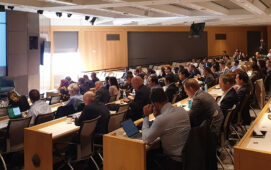What is connectivity?
How to define connectivity in the high-performance trading infrastructure segment depends on where you sit in what’s increasingly viewed as the financial ecosystem. At the FISD’s recent Low-Latency Roundtable event in London, I asked a group of esteemed supplier panellists how financial markets users should decide on which application type is the most appropriate point of entry to this ecosystem.
As I see it, there are a number of candidates for consideration. At one end of the chain, OMS and/or EMS platform suppliers could lay claim to giving their customers the first point of entry to the markets. Execution gateway suppliers assert a similar qualification, bolstered, they say, by growing regulation around the pre-trade risk requirement.
Nonsense, say network services suppliers. Indeed, at the FISD event BT’s Chris Pickles’ presentation centred on the question: Who owns your connections? It’s a pertinent question, and all is not always what it seems. Scratch the very surface of who is supplying your network connection and you may just find your telco – effectively your retail provider – relies heavily, or even totally, on third-party wholesale suppliers.
For some, mostly larger sell-side firms, this kind of set-up can introduce unacceptable overheads in terms of vendor management and the latency introduced by multiple message hops. (Of course, for some routes, this is unavoidable.)
But for others – Tier 2s on down to small prop shops, hedge funds and the like – the managed services approach to telco market connections can offer some real benefits.
That, it appears, is the thinking behind FXecosystem’s new Cable 2.0 service, which has just been announced after two or three months of operations for a number of clients. Cable 2.0 – named for the FX market term for the US dollar/Sterling rate, itself so named after the steel wires that facilitated price transmission between New York and London after a telegraph link was first laid in 1858 – aims to provide small to medium-sized players with the kinds of performance enjoyed by their larger competitors.
According to Jon Vollemaere, co-founder of FXecosystem, Cable 2.0 will allow such players to minimise latency, while benefiting from greater bandwidth, efficient alternate access routes and consistent round-trip delay. FXecosystem reckons it can provide SLA times of 66.35 milliseconds on its primary route and 68.4 milliseconds on its diverse secondary route. It’s also integrated with FXecosystem’s so-called FX Meet Me Room, from whence clients can connect totheir selected onward journey providers.
Perhaps most interesting is that FXecosystem can offer a wide range of connectivity performance – and hence rates – to suit the specific needs and resources of the client. This in part is due to the choice of routes available, with Global Crossing’s Atlantic Crossing (AC) link providing primary connectivity, and others – possibly including the Yellow/AC2 transatlantic cable, operated jointly by Level 3 and Global Crossing, and Hibernia Atlantic’s existing link – providing secondary connectivity.
Both are acknowledged leaders in terms of transatlantic roundtrip latency. And Vollemaere says more alternatives are in the works, the first very soon. His choice has widened this year as the likes of Abovenet have introduced super-fast transatlantic links aimed at the trading fraternity. Longer-term, Vollemaere says FXecosystem hopes to make use ofHibernia Atlantic’s planned much-vaunted Exchange connection, for which it recently secured funding for cable-laying.
With high frequency and other types of electronic trading gaining serious traction in the FX markets – possibly a flight from the possibility of stultifying regulation in listed markets – initiatives like FXecosystem could be the catalyst for allowing the many very interested smaller trading outfits compete with the big boys.
Subscribe to our newsletter




